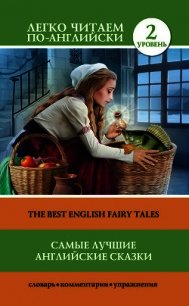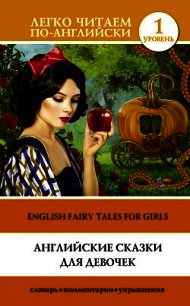More English Fairy Tales - Jacobs Joseph (читать книги полностью txt) 📗
Lost shoe. || Lost shoe. || Lost shoe. || Lost shoe.
Shoe marriage test. || Shoe marriage test. || Shoe marriage test. || Shoe marriage test.
Mutilated foot (housewife’s daughter). || Mutilated foot. || Mutilated foot. || Mutilated foot
Bird witness. || False bride. || False bride. || False bride.
Happy marriage. || Bird witness. || Bird witness. || Bird witness (raven).
House for red calf. || Happy marriage. || Happy marriage. || Happy marriage.
Remarks.—In going over these various versions, the first and perhaps most striking thing that comes out is the substantial agreement of the variants in each language. The English—i.e., Scotch, variants go together; the Gaelic ones agree to differ from the English. I can best display this important agreement and difference by the accompanying two tables, which give, in parallel columns, Miss Cox’s abstracts of her tabulations, in which each incident is shortly given in technical phraseology. It is practically impossible to use the long tabulations for comparative purposes without some such shorthand.
MACLEOD. || CAMPBELL. || SINCLAIR. || CURTIN. Heroine, daughter of sheep, king’s wife. || Ill-treated heroine (by stepmother). || Ill-treated heroine (by stepmother and sisters). || Ill-treated heroine (by elder sisters). || Menial heroine. || Menial heroine. || Menial heroine. || Helpful animal. || Helpful cantrips. || Henwife aid. Spy on heroine. || Spy on heroine. || Magic dresses (+ starlings on shoulders). || Magic dresses (honey-bird finger and stud). Eye sleep threefold. || Eye sleep. || Meeting-place (church). || Meeting place (church). Slaying of helpful animal mother. || Slaying of helpful animal. || Flight twofold. || Flight threefold. Revivified bones. || Revivified bones. || Lost shoe. || Lost shoe. Magic dresses. || Step-sister substitute. || Shoe marriage test. || Shoe marriage test. || Golden shoe gift (from hero). || Heroine under washtub. || Mutilated foot. Meeting-place (feast). || Meeting-place (sermon). || Happy marriage. || Happy marriage. Flight threefold. || Flight threefold. || Substituted bride. || Substituted bride (eldest sister). Lost shoe (golden). || Lost shoe. || Jonah heroine. || Jonah heroine. Shoe marriage test. || Shoe marriage test. || Three reappearances. || Three reappearances. Mutilated foot. || Mutilated foot. || Reunion. || Reunion. || False bride. || || Villain Nemesis. Bird witness. || Bird witness. || || Happy marriage. || Happy marriage.
Now, in the “English” versions there is practical unanimity in the concluding portions of the tale. Magic dresses—Meeting-place (Church)—Flight—Lost Shoe—Shoe Marriage-test—Mutilated foot—False Bride—Bird witness—Happy Marriage, follow one another with exemplary regularity in all four (six) versions. [2] The introductory incidents vary somewhat. Chambers has evidently a maimed version of the introduction of Catskin (see No. lxxxiii.). The remaining three enable us, however, to restore with some confidence the Ur-Cinderella in English somewhat as follows: Helpful animal given by dying mother—Ill-treated heroine—Menial heroine—cornucopia—Spy on heroine—Slaying by helpful animal—Tasks—Revivified bones. I have attempted in my version to reconstruct the “English” Cinderella according to these formul?. It will be observed that the helpful animal is helpful in two ways (a) in helping the heroine to perform tasks; (b) in providing her with magic dresses. It is the same with the Grimms’ Aschenputtel and other Continental variants.
Turning to the Celtic variants, these divide into two sets. Campbell’s and Macleod’s versions are practically at one with the English formula, the latter with an important variation which will concern us later. But the other two, Curtin’s and Sinclair’s, one collected in Ireland and the other in Scotland, both continue the formula with the conclusion of the Sea Maiden tale (on which see the Notes of my Celtic Fairy Tales, No. xvii.). This is a specifically Celtic formula, and would seem therefore to claim Cinderella for the Celts. But the welding of the Sea Maiden ending on to the Cinderella formula is clearly a later and inartistic junction, and implies rather imperfect assimilation of the Cinderella formula. To determine the question of origin we must turn to the purer type given by the other two Celtic versions.
Campbell’s tale can clearly lay no claim to represent the original type of Cinderella. The golden shoes are a gift of the hero to the heroine which destroys the whole point of the Shoe marriage test, and cannot have been in the original, wherever it originated. Mr. Macleod’s version, however, contains an incident which seems to bring us nearer to the original form than any version contained in Miss Cox’s book. Throughout the variants it will be observed what an important function is played by the helpful animal. This in some of the versions is left as a legacy by the heroine’s dying mother. But in Mr. Macleod’s version the helpful animal, a sheep, is the heroine’s mother herself! This is indeed an archaic touch, which seems to hark back to primitive times and totemistic beliefs. And more important still, it is a touch which vitalises the other variants in which the helpful animal is rather dragged in by the horns. Mr. Nutt’s lucky find at the last moment seems to throw more light on the origin of the tale than almost the whole of the remaining collection.
But does this find necessarily prove an original Celtic origin for Cinderella? Scarcely. It remains to be proved that this introductory part of the story with helpful animal was necessarily part of the original. Having regard to the feudal character underlying the whole conception, it remains possible that the earlier part was ingeniously dovetailed on to the latter from some pre-existing and more archaic tale, perhaps that represented by the Grimms’ One Eyed, Two Eyes, and Three Eyes. The possibility of the introduction of an archaic formula which had become a convention of folk-telling cannot be left out of account.
The “Youngest-best” formula which occurs in Cinderella, and on which Mr. Lang laid much stress in his treatment of the subject in his “Perrault” as a survival of the old tenure of “junior right,” does not throw much light on the subject. Mr. Ralston, in the Nineteenth Century, 1879, was equally unenlightening with his sun-myths.
LXXIV. KING O’ CATS
Source.—I have taken a point here and a point there from the various English versions mentioned in the next section.
I have expanded the names, so as to make a jingle from the Dildrum and Doldrum of Hartland.
Parallels.—Five variants of this quaint legend have been collected in England: (1) Halliwell, Pop. Rhymes, 167, “Molly Dixon”; (2) Choice Notes—Folk-Lore, p. 73, “Colman Grey”; (3) Folk-Lore Journal, ii., 22, “King o’ the Cats”; (4) Folk-Lore—England (Gibbings), “Johnny Reed’s Cat”; (5) Hartland and Wilkinson, Lancashire Legends, p. 13, “Dildrum Doldrum.” Sir F. Palgrave gives a Danish parallel; cf. Halliwell, l.c.
Remarks.—An interesting example of the spread and development of a simple anecdote throughout England. Here again we can scarcely imagine more than a single origin for the tale which is, in its way, as weird and fantastic as E.A. Poe.
2
Chamber's II. consists entirely and solely of these incidents.


